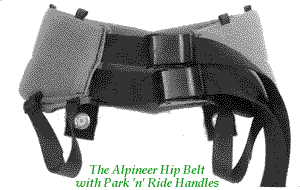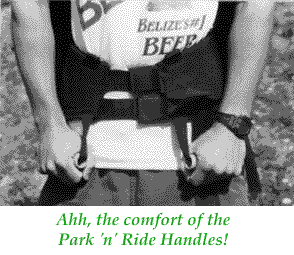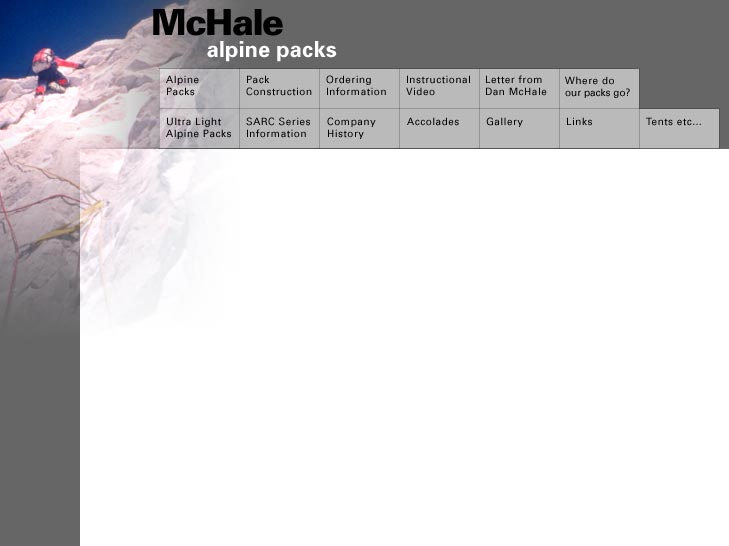| |
The 'Critical Mass' Hip Belt
Backpackers and mountaineers alike find our Critical Mass
(CM) packs to be great load carriers. Many people say it
is the hip belt that makes the pack so effective. They're
right. The hip belt and hip belt connection was the first
area of backpacks Dan McHale studied back in 1971 at a backpack
shop called Mountain Life, near San Jose, California.
One of Dan's jobs was fitting the external frames that were sold.
What they all had in common were the full wrap belts that were
to disappear in the oncoming internal-frame revolution.
Dan did not know at the time that his future would include manufacturing
his own line of internal-frame packs that would have external-frame
type hip belts and frames that would have the supportive strength
of externals.
When the hip belt comes first -- instead of last -- in the design
process, an interesting thing happens: the belt is free to wrap
all the the way around the pelvis without interference from a
yet nonexistent pack and lumbar pad. Our special attachment
points are at the bottom tail edge of the belt so that the load
can sheer load off the base of the belt. This makes it possible
for the load to spread upward throughout the entire belt.
The lumbar/sacrum pad is behind the belt and is part of the pack
where it cannot interfere with the 360 degree tension band of
the belt. It is an effective system. We know.

Carried by people that are fit and have done their training, the
CM system can carry over 100 lb. loads comfortably. Conventional
systems will strangle you with this kind of weight. When
people try packs on at our Seattle store, it is common for them
to estimate they are carrying only 1/2 to 2/3 of what is actually
in the pack. A McHale pack with 70 lb. can feel better than
other high-tech brands carrying only 50 lb. No other brand
has the frame structure or the belt performance to do the job
as effectively. We guarantee your satisfaction even when
comparing to any external-frame system. What does this mean
for our backpacking customers? Normal/traditional 45-65
lb. loads are an amazing pleasure to carry.
The shape of the belt is also important. Our belt design
is the result of studying how active rectangular panels wrap around
the side of the pelvis. Laid flat on the flare of the hip,
a panel will wrap downward to the front and rear. The panel
from one side of the pelvis will intersect the panel from the
other side in a wide angle V at the front and rear of the pelvis.
The angle at the rear of the belt is fixed, an effective average
of many we have tried. Dan actually experimented with adjustable
angle belts during the late 1970's to conclude that people did
not vary enough in this respect to warrant the complications involved.
A More Effective Hipbelt
The 'Critical Mass' hip belt will run circles around the performance
levels of any other hip belt currently on the market. This
includes those belts that other companies build special angles
into. There is no place for hype in belt design. Most belts
are over-engineered in padding and under-engineered in load distribution.
To achieve the angle at the front of the belt, we incorporate
two Swedish Fix-Lock cam buckles or 2 side-release buckles for
lighter loads. The Swedish Fixloc cam buckle is at the top
of our list for being unbreakable for extremely heavy loads and
it does not slip. It is also easy to adjust and can be released
with an injured hand. The downside of the cam buckle is that
it must always be adjusted with both hands. The foam in the belt,
imported from England, is called Evazote and is wrapped with a
combination of bias cut 500 and 1000 denier Cordura that will
gradually mold itself to the iliac areas of the pelvis.
You will not find plastic stiffeners in our hip belts either.
The belts wrap so effectively that they create their own firm
structure. Belt stiffeners are the current hallmark of high-tech
packs. It is really too bad real people are not as insensitive
as mannequins because we think the new crop of belts on the market
are a step backward in comfort. Are the people designing
this stuff really using it? We can safely predict that our
belts will not go down that dead end trail. Not only does
McHale Packs have the best belt, but we even build them in five
different heights and custom fit them to the nearest 1/2 inch
of length.

The Park 'N' Ride handles have proven to be an important addition
to the belt for backpackers. The most obvious purpose of
the handles is to provide a place to rest and park the arms.
They give your hands and arms a place to hang out while you walk
down the trail. For extremely (over 75 lbs.) heavy loads
this translates into being able to control the tilt of the pelvis
with very little effort. Since almost all of the pelvis
is forward of the sacral connection to the spine, there is a built
forward lever arm that simply needs a handle to counterbalance
the heavy load on the rear. By controlling pelvic tilt,
the belt can be worn higher with heavy loads because the belt
no longer tilts back into the belly above the iliac spine (front
hip bones). This improves leg circulation and mobility.
The double buckles also keep the belt from flipping or rotating
into the stomach. The tension band created by single buckles that
runs laterally through the center of normal belts sets up a fulcrum
point for the belt to roll inward to the stomach provided the
belt even reaches as far as the front hip bobes.
Since our belt works so much better and loads your hips as much
as you dare, clothing worn under the belt should be deliberately
chosen. Levi type pants, as an example, are out of the running
because of the heavy belt loops, rivets, and massive 4-way seam
that sits right in the center of the sacrum. Although Levis
are an extreme example, as much attention should be paid to how
your clothing works with the hip belt as you would pay to anything
else. People have gotten so used to having to carry the
load on the shoulders, even with the newer packs, that they almost
completely overlook this area when they get one of our packs. Ski
bibs are much better than ski pants, for instance, because they
do not end under the belt.
|
|
